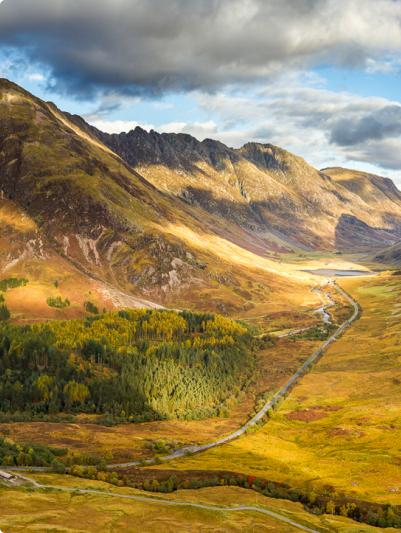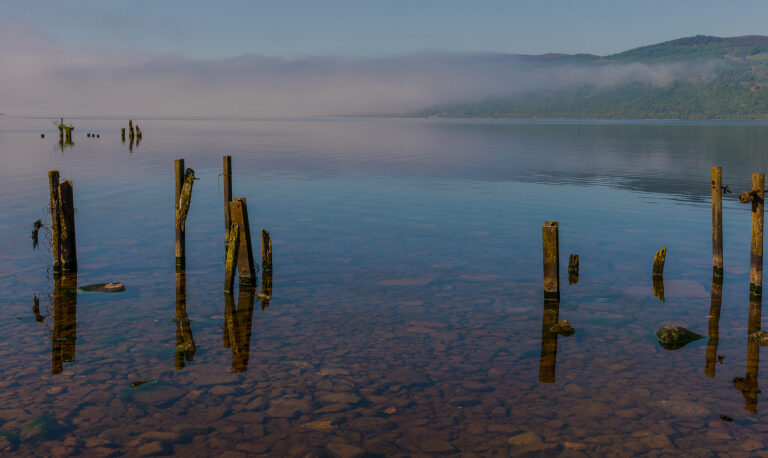Walking Back in Time on Dorset’s Jurassic Coast
The spectacular Jurassic Coast, England’s first UNESCO-designated natural World Heritage Site, covers 95 miles of stunning coastline from east Devon to Dorset.
This is one of the most popular stretches of the South West Coast Path, with 185 million years of Earth’s history embedded within the dramatic cliffs, caves, and coves. Walking along the Jurassic Coast is a memorable journey through time whilst enjoying the breathtaking scenery.
Here are just some of the treasures you can discover on the way …
Triassic Red Cliffs
It all begins with one of the most striking features of this section of coastline – the undulating red cliffs spanning the route between Exmouth and Sidmouth. These towering layers of sandstone offer a unique glimpse into the world during the Triassic period, 200 – 250 million years ago. At that time, the land here was a vast dry desert.
The coastal route along the clifftops takes in the spectacular sandstone sea stacks of Ladram Bay and past the tranquillity of the Otter Estuary Nature Reserve. A fairly steep, but manageable climb takes you up the wooded slopes of High Peak.
Along the way, allow some time to explore the independent shops, cafes, and local museums within the bustling seaside towns of Budleigh Salterton and Sidmouth. Suitably refreshed and caffeinated, the walk continues …
View this post on Instagram
Village of Beer
Traversing a little further along the coast, you’ll witness an extraordinary change in geology, with the vivid red earth giving way to a burst of striking white chalk cliffs.
The route zig-zags to the top of Beer Head, looking out across to Seaton Bay, before descending into the quaint fishing village of Beer.
Sheltered by towering white cliffs and dotted with deep caves, this village was once a veritable hot spot for smugglers and pirates to stash their stolen and illegal goods. Today, Beer’s ‘suntrap’ beach is the perfect place to relax after a long day’s walk.
View this post on Instagram
Undercliff National Nature Reserve
Shortly after passing the town of Seaton, the coastal path descends into the dense jungle-like woodland of Undercliff National Nature Reserve.
The reserve is one of the largest coastal landslide systems in Western Europe. The landslides from the past have created gulleys and pockets that have since become densely vegetated and created a rare and unusual habitat for plants and birds. The landscape is, thankfully, now stable.
Although enclosed for some hours with occasional glimpses of the sea beyond, there is still plenty to look out for. The Undercliff is humid and sheltered, providing a perfect habitat for ferns, fungi, wildflowers, and many different insects, as well as foxes and roe deer. A mixture of ash, hazel, beech, holm oak and sycamore trees provides a beautiful canopy. Its nature reserve status means that sticking to the marked path is required.
View this post on Instagram
Lyme Regis
Eventually, you’ll emerge from the depths of Undercliff and arrive at the historic harbour town of Lyme Regis, which is set against the cliffs on the border between Devon and Dorset. This is a great place for a leisurely wander, with a fantastic selection of restaurants and an abundance of independent gift shops selling rare seashells.
But what makes Lyme Regis such an important spot on the Jurassic Coast is the huge number of prehistoric fossils found in the area. Around the year 1811, the famous Georgian palaeontologist, Mary Anning, discovered the first Ichthyosaur skeleton at the age of 12 on Lyme Regis beach.
Today, the award-winning Lyme Regis Museum offers further insight into the life and discoveries of Mary Anning, as well as the findings of the many fossil collectors that have followed in her footsteps.
View this post on Instagram
Charmouth Beach
From Lyme Regis, the coast path heads inland slightly before dropping back to the sea at Charmouth.
Rapid erosion along this section of the cliff face has resulted in thousands of fossils being deposited on the beach. This is said to be one of the best places to search for fossils in the UK – for those that know a rock from a fossil!
While on your Jurassic Coast adventure, wander along Charmouth Beach, turn over a few stones and look for the remnants of animals etched in the rock. Alternatively, many fossils can be found on display in the heritage centre by the beach.
View this post on Instagram
Golden Cap
At 191 metres, Golden Cap is the highest point on the south coast of England.
Located between Charmouth and Bridport, it’s made up of rocks from both the Jurassic and Cretaceous periods. This gives the cliff a combination of dark grey layers interspersed with bright orange rock. When hit by the sun, this combination gives the cliff face a brilliant golden hue.
Topped with a blanket of lush green grass, it is one of the most idyllic and scenic spots on the Jurassic Coast, with expansive views out to sea.
View this post on Instagram
Village of Abbotsbury
The coastal adventure continues along rolling cliff tops, into areas of woodland, and across farmland, towards the charming village of Abbotsbury. With its stone and thatch cottages dating back to the 16th century, cosy tea rooms, and olde worlde pubs, this historic village is as quintessentially English as they come.
From March to October, the Abbotsbury Swannery is well worth a visit. It is filled with hundreds of swans relaxing in the protected water during nesting season. Or you can stroll around the Subtropical Gardens, a magnificent Victorian Walled garden with a unique micro-climate which enables rare and tropical species to thrive.
Perched high on a hill overlooking the village is St Catherine’s Chapel, a 14th-century chapel built by the monks of Abbotsbury Abbey as a place of pilgrimage and retreat. It is a steep climb up to the chapel, but you are rewarded with sweeping views across the coastline and the famous Chesil Beach.
View this post on Instagram
Chesil Beach
This unique pebble arc stretches 18 miles along the coast from West Bay to the Isle of Portland. The beach is separated from the mainland by the fascinating expanse of saline water called Fleet Lagoon, an important natural wildlife habitat for many species of birds, fish, and plants.
This unusual landscape offers some spectacular vistas as the coastal path continues along the cliffs towards the bustling town of Weymouth.
View this post on Instagram
Isle of Portland
Joined to the mainland by Chesil Beach, the Isle of Portland stretches out into the English Channel. A full circuit of Portland takes in Portland Bill at the southern tip of the island, as well as several abandoned quarries.
The Tout Quarry has become a lovely sculpture park and nature reserve, offering a unique habitat for rare flora and fauna. It’s a fairly long additional loop of the coastal path and requires a full day to explore.
View this post on Instagram
Weymouth
Throughout the year, the large harbour town of Weymouth is home to various music festivals and arts events. A place where old meets new, once derelict warehouses perched on the sea walls have been wonderfully transformed into trendy pubs and hotels. Vintage breweries form the backdrop to charming squares.
Meanwhile, you can sit by the shore watching fishermen chug their boats up and down the waterways surrounded by colourful houses, boutique shops, and guest houses. It’s a great place for a slow meander and a sneak peek into the local life of a thriving seaside town.
View this post on Instagram
Durdle Door
Leaving the hustle and bustle of urban life behind, the coastal path continues over impressive chalk cliffs towards one of the most iconic and photographed landmarks in England, Durdle Door.
This spectacular limestone archway lives up to its hype and is undoubtedly one of the highlights of the Jurassic Coast. The coastal path takes you to the edge of the clifftop, with expansive views over the shingle beach and archway below.
The seabed here is full of chalk, giving the sea a dazzling blue hue reminiscent of beaches from distant tropical shores.
View this post on Instagram
Lulworth Cove
Just east of Durdle Door is the picturesque Lulworth Cove. This circular cove is surrounded by a sweeping arc of pebbles and backed by steep cliffs. When the tide is low, rock pools are revealed, bursting with all sorts of strange and wonderful creatures. If you are a fan of the ancient art of rockpooling, this is the place to spend a couple of leisurely hours.
Just above the cove is another interesting phenomenon, the Lulworth Crumple, where layers of black, grey, and white rock are slowly collapsing into the sea, creating a fascinating ripple effect.
To the east of Lulworth Cove is the Fossil Forest; a cluster of fossilised tree stumps and roots formed around 150 million years ago, now preserved in the sea floor.
View this post on Instagram
St Aldhelm’s Head
The path across the Lulworth Ranges to St Aldhelm’s Head is one of the most isolated but rewarding sections of the route, taking in spectacular natural and historical sights including Worbarrow Tout, Flowers Barrow, and Tyneham Cap.
The Norman chapel of St Aldhelm is one of the oldest churches in England, serving not only as a place of worship but also as a marker for seafarers. The National Coastguard lookout can also be found here, as well as a memorial to the radar research which took place on St Aldhelm’s Head during WWII. Some other sights of interest along this section of the coast include the long-abandoned Winspit Quarry and the unusual Dancing Ledge, a natural rock shelf jutting out into the sea.
The day ends with a walk inland to the quaint village of Worth Matravers, dating back to pre-Roman times, where you can sit down with a well-deserved pint at the historic Square and Compass pub.
View this post on Instagram
Corfe Castle
When the Lulworth Ranges are closed to the public, there is an alternative route inland via Corfe Castle. Well worth a visit in its own right, Corfe Castle is one of the earliest Norman-built castles, after their invasion of England in 1066. The castle stands high on a hill overlooking the Dorset countryside and Corfe Village below.
The village is also a great place to explore, where traditional pubs, bakeries, and independent shops sit amongst attractive cottages.
View this post on Instagram
Swanage
Walking becomes a little easier as you head through the Durlston Country Park and National Nature Reserve towards the seaside town of Swanage.
Once an important quarrying port, Swannage is now a popular destination for tourists with its attractive Victorian pier and the Wellington Clock Tower which, up until 1867, stood at the southern end of London Bridge. The town makes an interesting place to stop for refreshments and wander around.
View this post on Instagram
Old Harry Rocks
Nearing the end of the trail, at the easternmost point of the Jurassic Coast, stand the Old Harry Rocks. These striking chalk stacks, carved out by the sea, were once part of a chalk ridge which led right out to the Isle of Wight. In the far distance, on a clear day, you can spot The Needles emerging from the sea by the Isle of Wight, where the land used to be linked. The Jurassic Coast World Heritage Site ends just beyond the Old Harry Rocks.
Three miles of sandy beaches running all the way to South Haven Point offer plenty of opportunities to rest and take in the views across Poole Bay to Bournemouth and the Isle of Wight. Just before reaching the ferry to Sandbanks, a steel sculpture marks the end of the South West Coast Path.
View this post on Instagram
Discover the Jurassic Coast
The Jurassic Coast section of the South West Coast Path offers a rewarding mix of varied walking, incredible scenery, fascinating geological and historical sights, bustling coast towns, and peaceful villages.
At every turn, there is a view to take in, a place to rest and watch the world go by, and something to learn about Earth’s long history.
Rebecca Meacham


